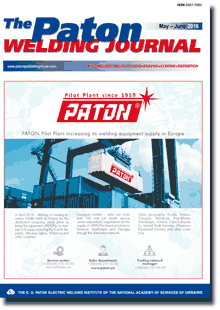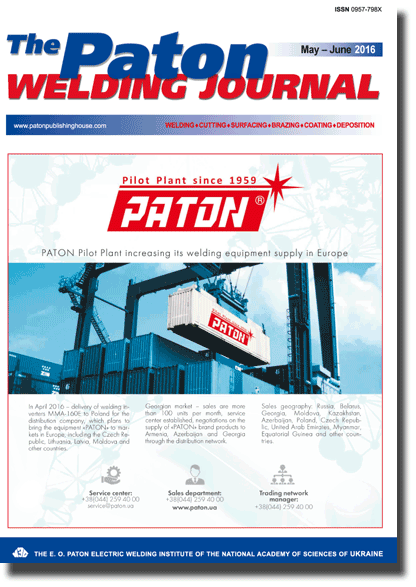| 2016 №06 (14) |
DOI of Article 10.15407/tpwj2016.06.15 |
2016 №06 (16) |

The Paton Welding Journal, 2016, #5-6, 86-90 pages
Features and advantages of the process of friction stir welding of butt joints of sheet aluminium-lithium alloys
A.G. Poklyatsky, V.V. Knysh, I.N. Klochkov And S.I. Motrunich
E.O. Paton Electric Welding Institute, NASU 11 Kazimir Malevich Str., 03680, Kiev, Ukraine. E-mail: office@paton.kiev.ua
Abstract
The paper analyzes the structural features, strength and fatigue life properties of sheet joints of Al–Li alloys 1420 and 1460, produced by nonconsumable-electrode argon-arc welding and friction stir welding. It is shown that application of FSW provides formation of permanent joints with minimum level of stress concentration in the points of weld transition to base material and allows avoiding defects in welds in the form of pores, oxide film macroinclusions or hot cracks due to melting and solidification of metal in fusion welding. Here, intensive plastic deformation of metal under the tool shoulder and in weld nugget results in formation of fine-crystalline (3–4 µm) uniform disoriented structure, and grain elongation and distortion in the direction of plasticized metal displacement proceed in adjacent sections. This leads to increase of hardness and ultimate strength of joint weld metal. Lowering of the temperature of heating of the edges being welded provides reduction of maximum level of tensile residual longitudinal stresses in welded joints, compared to TIG welding. It is found that fatigue resistance characteristics of butt welded joints, made by FSW, are superior to those of the joints, made by TIG welding. 10 Ref., 9 Figures.
Keywords: Al–Li alloys, friction stir welding, defects, microstructure, ultimate strength, fatigue resistance
Received: 28.03.16
Published: 19.07.16
References
- Beletsky, V.M., Krivov, G.A. (2005) Aluminium alloys (composition, properties, technology, application)n: Refer. Book. Ed. by I.N. Fridlyander. Kiev: KOMINTEKh.
- (2002) Aircraft materials: Transact. of VIAM 1932–2002, 424. Moscow: MISIS VIAM.
- Bratukhin, A.G. (2003) Modern aircraft materials: Technological and functional peculiarities. Moscow: Aviatekhinform.
- Rabkin, D.M., Lozovskaya, A.V., Sklabinskaya, I.E. (1992) Metals science of aluminium and its alloys. Kiev: Naukova Dumka.
- Mashin, V.S., Poklyatsky, A.G., Fedorchuk, V.E. (2005) Mechanical properties of aluminium alloys in consumable and nonconsumable electrode arc welding. The Paton Welding J., 9, 39–45.
- Thomas, W.M., Nicholas, E.D., Needham, J.C. et al. Friction stir butt welding. Int. Pat. PCT/GB 92/02203; GB Pat. Appl. 9125978.8. Publ. 1991.
- Defalco, J. (2006) Friction stir welding vs. fusion welding. Welding J., 3, 42–44.
- Ericsson, M., Sandstrom, R. (2003) Influence of melting speed on the fatigue of friction stir welds and comparison with MIG and TIG. J. Fatigue, 25, 1379–1387. https://doi.org/10.1016/S0142-1123(03)00059-8
- Enomoto, M. (2003) Friction stir welding: Research and industrial applications. Welding Int., 5, 341–345.
- Ishchenko, A.Ya., Poklyatsky, A.G. Tool for friction stir welding of aluminium alloys. 54096 Ukraine. Int. Cl. B23K 20/12. Fil. 30.04.2010. Publ. 25.10.2010.
Suggested Citation
A.G. Poklyatsky, V.V. Knysh, I.N. Klochkov And S.I. Motrunich (2016) Features and advantages of the process of friction stir welding of butt joints of sheet aluminium-lithium alloys. The Paton Welding J., 06, 86-90.The cost of subscription/purchase order journals or individual articles
| Journal/Currency | Annual Set | 1 issue printed |
1 issue |
one article |
| TPWJ/USD | 384 $ | 32 $ | 26 $ | 13 $ |
| TPWJ/EUR | 348 € | 29 € | 24 € | 12 € |
| TPWJ/UAH | 7200 UAH | 600 UAH | 600 UAH | 280 UAH |
| AS/UAH | 1800 UAH | 300 UAH | 300 UAH | 150 UAH |
| AS/USD | 192 $ | 32 $ | 26 $ | 13 $ |
| AS/EUR | 180 € | 30 € | 25 € | 12 € |
| SEM/UAH | 1200 UAH | 300 UAH | 300 UAH | 150 UAH |
| SEM/USD | 128 $ | 32 $ | 26 $ | 13 $ |
| SEM/EUR | 120 € | 30 € | 25 € | 12 € |
| TDNK/UAH | 1200 UAH | 300 UAH | 300 UAH | 150 UAH |
| TDNK/USD | 128 $ | 32 $ | 26 $ | 13 $ |
| TDNK/EUR | 120 € | 30 € | 25 € | 15 € |
AS = «Automatic Welding» - 6 issues per year;
TPWJ = «PATON WELDING JOURNAL» - 12 issues per year;
SEM = «Electrometallurgy Today» - 4 issues per year;
TDNK = «Technical Diagnostics and Non-Destructive Testing» - 4 issues per year.


